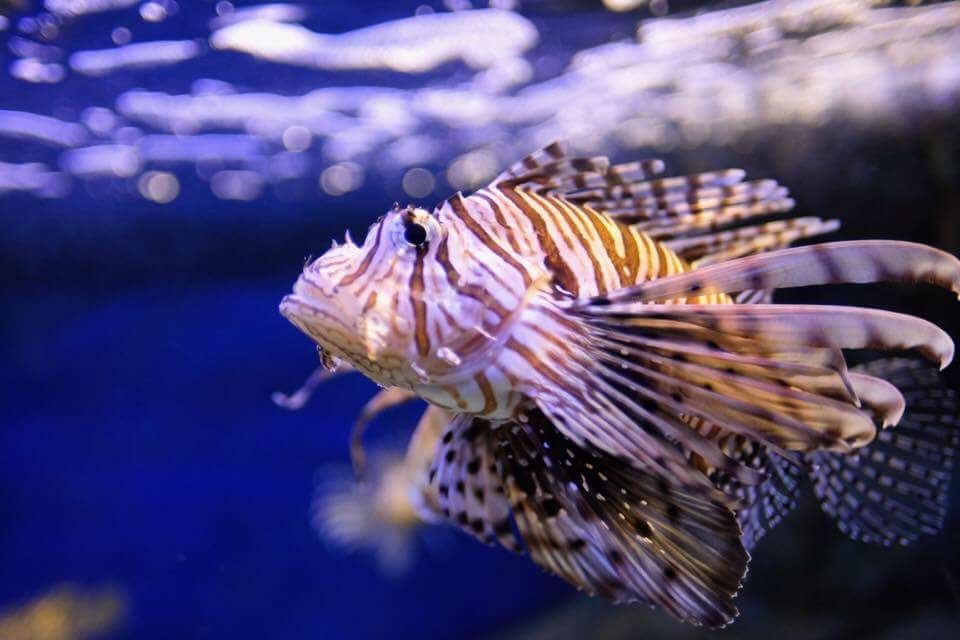When we think of fish, we often imagine them gracefully gliding through the water, their bellies facing the ocean floor. However, there are a few fascinating species that defy this norm by swimming upside down.
These unique swimmers include the upside down catfish, lionfish, upside down whipnose anglerfish, and upside down jellyfish.
This blog post explores the intriguing reasons behind their unusual behaviour, their habitats, diets, and other fascinating facts. Let’s dive into the world of these extraordinary fish!
Upside down catfish
The upside down catfish (Synodontis nigriventris) swims upside down to feed on insects and plant matter that float on the surface of the water. This unique orientation allows them to efficiently access food sources that are less accessible to other fish.
The upside down catfish predominantly swims upside down but can swim normally when needed. This behaviour is primarily observed when they are feeding or resting.
These fish have a distinctive appearance with a flattened belly and a darker back, which helps them blend in with the water’s surface when viewed from below. This camouflage technique is a defensive mechanism against predators.
Native to the slow-moving waters of the Congo Basin in Central Africa, they prefer environments with plenty of hiding spots like submerged logs and dense vegetation. Their diet consists mainly of insects, plant matter, and small crustaceans.
Known for their social behaviour, upside down catfish are often found swimming in schools. They are nocturnal and prefer to be active during the night. In the wild, they can live up to five years, while in captivity, with proper care, they can live up to eight years.
Lionfish

Lionfish (Pterois) can often be seen swimming upside down due to their high control over their swim bladder, which allows them to switch between upright and inverted swimming with ease. This behaviour is useful for hunting as it provides a strategic advantage in ambushing prey.
Lionfish are capable of both normal and upside-down swimming, often alternating between the two based on their needs. Known for their vibrant colours and distinctive spines that fan out around their bodies, lionfish have a striking appearance that serves as both a warning to potential predators and a means of camouflage among coral reefs.
Typically found in the warm waters of the Indo-Pacific region, especially around coral reefs, they are carnivorous, preying on smaller fish and invertebrates. Their ability to swim upside down helps them ambush prey more effectively.
As solitary predators, lionfish are often seen patrolling their territory in search of food. They are also known for their invasive nature, particularly in the Atlantic Ocean, where they have few natural predators. Lionfish can live up to fifteen years in the wild. You can check out the Volitan Lionfish at Tynemouth Aquarium.
Whipnose anglerfish
The whipnose anglerfish (Caulophryne jordani) swims upside down as a predatory strategy. This orientation allows them to use their bioluminescent lure more effectively, attracting prey from below in the deep sea.
They swim upside down most of the time, especially when hunting. Their orientation can change if needed, but the upside-down position is most effective for their predatory tactics.
These fish have an elongated body and a bioluminescent lure that dangles from their head, which they use to attract prey. Their appearance is quite unique, with a whip-like extension from their chin that assists in their hunting methods.
Typically found in deep-sea environments, often at depths of 2000 to 3000 metres, their dark habitat necessitates their bioluminescent adaptations to attract prey.
These fish have a lifespan that is not well-documented due to the difficulty in studying deep-sea species, but they are believed to live several years.
Upside down jellyfish
The upside down jellyfish (Cassiopea) stays upside down to expose the algae that is attached to them to sunlight. This relationship allows the algae to photosynthesise and provide nutrients to the jellyfish
These jellyfish remain upside down almost constantly because their symbiotic relationship with algae is crucial for their survival.
Upside down jellyfish have a flattened bell and short tentacles that point upwards when they are resting on the ocean floor. This unique orientation distinguishes them from other jellyfish species.
Typically found in shallow, warm coastal waters, especially in mangrove swamps and lagoons where sunlight penetrates easily, they rely heavily on their symbiotic algae for nutrients but also capture plankton and small particles with their tentacles. Upside down jellyfish are known to form large aggregations, these jellyfish often cover the seabed in certain areas. Upside down jellyfish can live for several years, depending on environmental conditions and the availability of sunlight.
The world of fish is incredibly diverse, with some species adapting remarkable behaviours and characteristics that defy our usual expectations. From feeding strategies to symbiotic relationships, these upside-down swimmers provide a fascinating glimpse into the complexity of aquatic life.For a first-hand view of the incredible adaptations of marine life, book your tickets to Tynemouth Aquarium today.
